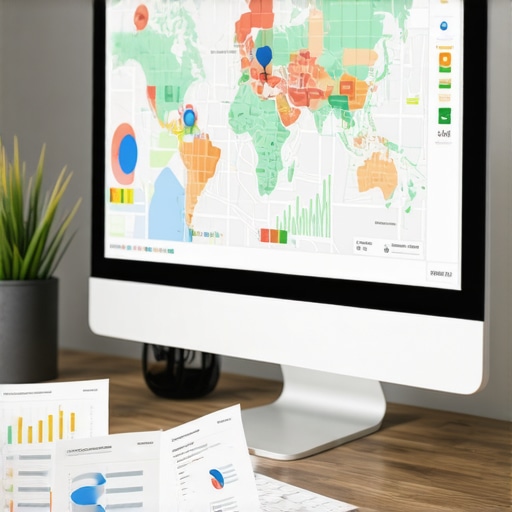Harnessing the Power of Geogrid Tracking for Superior Local SEO Performance
In the competitive realm of local search engine optimization, mastering Google Maps rankings has become imperative for businesses aiming for visibility dominance. The integration of geogrid tracking strategies offers a sophisticated approach to dissecting geographic data, enabling SEO professionals to craft highly targeted campaigns that outpace traditional methods. This article explores the nuanced layers of geogrid technology, emphasizing its potential to revolutionize local SEO efforts with proven techniques.
Theoretical Foundations and Practical Applications of Geogrid Mapping
At its core, geogrid mapping involves partitioning a geographical area into a structured grid, facilitating granular analysis of map rankings and local search performance. By deploying advanced GMB software, practitioners can monitor fluctuations within each grid cell, revealing spatial patterns that inform strategic adjustments. This precision allows for data-driven decisions, ultimately elevating a business’s prominence in hyper-local searches.
Advanced Data Collection and Analysis: The Next Frontier in Maps Optimization
Leveraging geogrid tracking transcends mere ranking observation; it involves a comprehensive analysis of environmental variables, user behavior, and algorithmic shifts. Integrating GIS (Geographic Information System) data with real-time tracking tools creates a multi-dimensional picture of local search landscapes. This layered approach uncovers hidden opportunities, such as underserved zones or emerging competitor territories, fostering targeted interventions that are both effective and scalable.
What Are the Key Challenges in Implementing Geogrid Strategies at Scale?
How can SEO professionals effectively manage the complexity of large-scale geogrid deployments without diluting their focus?
Managing expansive geogrids requires meticulous planning, automation, and robust data analysis frameworks. Utilizing specialized tracking tools enables continuous monitoring and rapid response to ranking fluctuations. Additionally, segmenting large areas into manageable zones allows for tailored strategies, ensuring focused resource deployment and sustained performance gains.
Integrating Geogrid Insights with Broader Local SEO Tactics
While geogrid tracking provides granular data, its true power is realized when integrated with holistic local SEO strategies. Combining geogrid insights with citation management, review optimization, and localized content creation enhances overall visibility. This synergy ensures that ranking improvements are not isolated but contribute to a comprehensive dominance in local search results.
Explore More: Unlock the Full Potential of Geogrid Tracking in Your SEO Arsenal
For professionals eager to deepen their understanding, exploring content at this resource provides actionable insights into leveraging geogrid techniques for maximum impact. Engage with industry peers and share your experiences to refine your strategies continually.
Unlocking the Next-Level Potential of Geogrid Techniques for Local SEO Domination
As the landscape of local search continues to evolve rapidly, SEO professionals are increasingly turning to innovative methods like geogrid tracking to gain a competitive edge. While foundational strategies have delivered solid results, the true power lies in harnessing advanced techniques that enable granular control and predictive analytics. This progression necessitates a nuanced understanding of geogrid technology, combined with strategic insights to stay ahead in 2024.
What Are the Emerging Trends in Geogrid Mapping That Can Transform Your Local SEO Campaigns?
Recent developments suggest that integrating machine learning algorithms with geogrid data can dramatically enhance prediction accuracy and responsiveness. By analyzing historical fluctuations within specific grid cells, SEO experts can forecast ranking trends and proactively adjust their tactics. This approach goes beyond simple monitoring; it involves creating dynamic models that adapt to real-time changes in algorithm behavior and user engagement patterns. For those aiming to elevate their local visibility, exploring these advanced predictive techniques is essential.
How can predictive geogrid analytics redefine your local SEO strategy in 2024?
Predictive analytics allows for anticipatory adjustments, meaning businesses can identify emerging opportunities or potential declines before they happen. For example, analyzing patterns across multiple grid zones can reveal underserved areas or rising competitors, enabling targeted interventions that optimize resource allocation. Combining these insights with comprehensive local SEO tactics—such as review management and localized content—creates a synergistic effect, driving sustained rankings and visibility.
Moreover, leveraging cutting-edge GMB software empowers marketers to automate large-scale geogrid deployments, ensuring continuous data collection and analysis without manual oversight. This integration ensures that strategies remain agile and data-driven in the face of rapid algorithm shifts.
Why Is Multi-Dimensional Data Analysis Crucial for Future-Proof Local SEO?
In the era of hyper-local search, relying solely on ranking metrics is no longer sufficient. Instead, combining geogrid data with environmental variables—such as demographic trends, competitor activity, and algorithmic updates—creates a multi-layered view of the local landscape. This comprehensive approach enables SEO professionals to craft more resilient and adaptable strategies, reducing vulnerability to sudden ranking fluctuations.
For instance, integrating Geographic Information System (GIS) data with geogrid analytics can uncover hidden opportunities in underserved zones, while also highlighting potential risks. This multi-dimensional insight is vital for developing long-term plans that sustain visibility despite evolving search algorithms and consumer behaviors.
Engage and Evolve: Share Your Experiences and Discover More
If you’re eager to explore how advanced geogrid tracking can revolutionize your local SEO efforts, check out this resource for actionable techniques. Don’t forget to share your insights or ask questions in the comments—collaborative learning accelerates success in such a complex, competitive field.
Harnessing Multi-Layered Data Integration to Elevate Local Search Visibility
In today’s hyper-competitive local SEO landscape, integrating diverse data sources has become not just advantageous but essential. Beyond traditional geogrid tracking, combining insights from demographic analytics, real-time user engagement metrics, and environmental variables creates a multidimensional strategic framework. This approach enables SEO professionals to identify emerging opportunities and mitigate potential risks with unprecedented precision.
For instance, leveraging Geographic Information System (GIS) data alongside geogrid analytics can reveal service gaps in underserved zones, while social media sentiment analysis offers real-time feedback on local brand perception. This fusion of data informs hyper-targeted campaigns that adapt dynamically to shifting local conditions, ultimately enhancing ranking resilience and customer engagement.
What Are the Critical Components of Multi-Dimensional Local SEO Data Analysis?
Key components include demographic profiling, competitor activity tracking, algorithmic trend analysis, and environmental scanning. Each element provides unique insights; demographic data helps tailor localized content, while competitor activity reveals strategic gaps or threats. Algorithmic trend analysis, especially when combined with machine learning, predicts shifts in search rankings, enabling proactive adjustments.
Furthermore, environmental scanning encompasses factors such as local economic trends, seasonal variations, and community events, which influence consumer behavior and search patterns. Integrating these layers into a cohesive dashboard allows for swift decision-making and enhanced strategic agility.
Applying Predictive Analytics to Forecast Local SEO Outcomes
Predictive analytics represents the frontier of strategic foresight, transforming reactive tactics into anticipatory actions. By analyzing historical geogrid fluctuations alongside external variables, SEO experts can construct dynamic models that forecast future ranking trends with remarkable accuracy. This capability facilitates resource optimization, enabling businesses to focus efforts on high-opportunity zones while preemptively addressing declining areas.
For example, machine learning algorithms can identify subtle patterns indicating upcoming algorithmic updates or shifts in user engagement, allowing preemptive content adjustments or review strategies. This predictive capacity empowers marketers to maintain a competitive edge even amidst rapid search landscape evolutions, ensuring sustained visibility and growth.
How Can Sophisticated Data Visualization Enhance Strategic Decision-Making?
Advanced data visualization tools translate complex multidimensional datasets into intuitive, actionable insights. Interactive heat maps, trend overlays, and real-time dashboards enable marketers to grasp geographic and temporal patterns quickly, facilitating rapid tactical shifts. These visualizations not only improve internal decision-making but also enhance stakeholder communication, ensuring alignment across marketing teams and executive leadership.
Investing in robust visualization platforms that integrate geogrid, demographic, and environmental data creates a comprehensive strategic cockpit. This setup supports continuous monitoring, scenario planning, and performance benchmarking—cornerstones of an adaptive, future-proof local SEO strategy.
Engage with Cutting-Edge Resources to Master Multi-Dimensional Local SEO Strategies
If you’re eager to deepen your expertise in integrating complex data layers into your local SEO campaigns, explore this authoritative resource for actionable insights. Sharing your experiences and questions fosters a collaborative learning environment, driving innovation and success in this fast-evolving field.
Harnessing Dynamic Geogrid Analytics to Outpace Competitors in Local Search
In an era where hyper-local search dominance hinges on precision and adaptability, leveraging cutting-edge geogrid analytics offers unparalleled strategic advantages. Advanced geospatial intelligence combined with real-time data streams empowers SEO professionals to craft hyper-targeted campaigns, addressing specific geographic nuances that traditional methods overlook. This approach transforms local SEO from reactive to predictive, enabling brands to anticipate market shifts and consumer behaviors before they materialize.
The Synergy of Geospatial Data and Machine Learning: Crafting Smarter Strategies
Integrating machine learning algorithms with geospatial datasets facilitates the development of predictive models that dynamically adapt to evolving search landscapes. These models analyze historical ranking fluctuations within each grid cell, identifying emerging patterns and potential disruptions. By harnessing this synergy, marketers can fine-tune their local SEO efforts with remarkable granularity, optimizing resource allocation and boosting visibility in underserved or high-growth zones.
How Can Multi-Layered Data Fusion Elevate Local SEO Campaigns?
Fusing diverse data streams—demographic insights, social media sentiment, environmental variables, and competitor activity—creates a multidimensional view of the local market. This holistic perspective enables the formulation of resilient strategies that withstand algorithmic volatility and shifting consumer preferences. For instance, overlaying GIS data with real-time engagement metrics can reveal unseen service gaps, informing targeted outreach that elevates local prominence.
What Are the Critical Challenges in Scaling Advanced Geospatial Strategies?
How do SEO professionals efficiently manage vast, complex geospatial datasets without sacrificing agility?
Managing large-scale geospatial data requires robust automation frameworks, scalable cloud infrastructure, and sophisticated analytical tools. Implementing AI-driven data processing pipelines ensures continuous monitoring and rapid response to ranking fluctuations. Segmenting geographic zones into manageable clusters allows for tailored strategies, maintaining focus and maximizing ROI across expansive markets.
Enhancing Visual Data Analysis for Strategic Precision
Next-generation data visualization platforms—interactive heat maps, temporal trend overlays, and predictive dashboards—translate complex geospatial insights into actionable intelligence. These tools facilitate swift tactical adjustments and foster stakeholder engagement through compelling visual narratives. Investing in such platforms ensures that decision-makers are equipped with real-time, intuitive insights necessary for agile strategy execution.

Incorporate a high-resolution, detailed heat map illustrating geogrid zones and ranking fluctuations to exemplify advanced data visualization in local SEO strategies.
Realizing Future-Proof Local SEO Through Adaptive Strategies
As search algorithms evolve and consumer behaviors become more localized and personalized, adaptive strategies grounded in multidimensional data analysis will be pivotal. Continuous refinement of predictive models, combined with proactive content and review management, ensures sustained visibility and competitive edge. Embracing these sophisticated techniques positions brands to thrive amid the complexities of the 2024 search landscape.
How Will Emerging AI Technologies Reshape Geospatial Optimization?
Emerging AI innovations, including deep learning and natural language processing, are set to revolutionize geospatial analysis by enabling nuanced understanding of consumer intent and contextual relevance. These technologies facilitate hyper-personalized local SEO strategies that resonate with targeted audiences, driving higher engagement and conversions. Staying ahead necessitates integrating AI-driven insights into existing geogrid frameworks.
What strategic advantages do AI-powered geospatial tools offer in competitive local markets?
AI tools enhance predictive accuracy, automate routine analysis, and uncover latent opportunities within complex datasets. They enable marketers to respond swiftly to market dynamics, optimize local content, and refine targeting with unprecedented precision. Embracing AI-driven geospatial solutions ultimately translates into a decisive competitive advantage, ensuring long-term dominance in local search rankings.
To explore these transformative strategies further, engage with experts through industry-specific forums and advanced analytical platforms. Implementing these innovative techniques will solidify your position at the forefront of local SEO excellence in 2024 and beyond.
Expert Insights & Advanced Considerations
Strategic Integration of Predictive Analytics
Utilizing predictive analytics within geogrid tracking allows SEO professionals to anticipate ranking fluctuations, enabling proactive adjustments that maintain competitive advantage. This approach involves analyzing historical data patterns across grid zones to forecast future movements, reducing reactive efforts and optimizing resource deployment.
Multi-Dimensional Data Fusion for Resilient Campaigns
Combining geogrid data with environmental variables, demographic trends, and competitor activities creates a comprehensive view of local markets. This multi-layered strategy enhances resilience against algorithm updates and market shifts, ensuring sustained visibility and engagement.
Advanced Visualization Techniques for Strategic Clarity
Implementing interactive heat maps and real-time dashboards transforms complex datasets into actionable insights. These tools facilitate rapid decision-making, scenario analysis, and stakeholder communication, thereby elevating strategic precision in local SEO campaigns.
Emerging AI Technologies and Geospatial Optimization
Integrating deep learning and natural language processing with geospatial data enables hyper-personalized local SEO strategies. These AI-driven tools improve prediction accuracy, automate routine analysis, and uncover latent opportunities, positioning brands at the forefront of local search dominance.
Scalability and Data Management Challenges
Managing vast, complex geospatial datasets requires scalable cloud infrastructure, robust automation frameworks, and sophisticated analytical platforms. Segmentation of geographic zones and AI-driven data processing pipelines are essential for maintaining agility and maximizing ROI across expansive markets.
Curated Expert Resources
- GMB Software Secrets & Tools: A comprehensive resource on innovative tools for local SEO enhancement, emphasizing geogrid integration.
- Mastering Geogrid Tracking: An authoritative guide on effective geogrid tracking techniques to optimize Google Maps rankings.
- Cutting-Edge Geogrid Tracking Tools: Insights into the latest tools and methodologies for advanced local SEO campaigns.
Final Expert Perspective
Embracing advanced geogrid tracking and predictive analytics represents the next frontier in local SEO mastery. Integrating multi-dimensional data and leveraging AI technologies will empower professionals to craft resilient, agile strategies capable of thriving amid rapid algorithm changes and evolving consumer behaviors. To deepen your expertise and stay ahead in 2024, explore these resources and share your insights with industry peers—collaboration is key to sustained success in this dynamic landscape.

